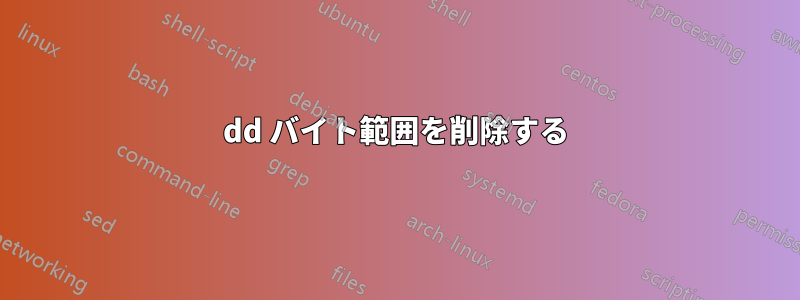
このファイル
$ cat hello.txt
hello doge world
バイトの範囲を削除して、最終的に次のようになります
$ cat hello.txt
heorld
可能であればこれをやりたいですdd。理由は、すでにddこの方法でバイトを上書きしているからです。
printf '\x5E' | dd conv=notrunc of=hello.txt bs=1 seek=$((0xE))
同じファイルに書き戻すことを好みますが、別の出力ファイルでも問題ありません。
答え1
ブロックサイズ、カウント、スキップを指定するだけです。
$ cat hello.txt
hello doge world
$ { dd bs=1 count=2 ; dd skip=3 bs=1 count=1 ; dd skip=6 bs=1 ; } <hello.txt 2>/dev/null
he orld
上記では、 を 3 回呼び出していますdd。最初は、 の最初の 2 文字を取得しますhe。2 番目は、 の末尾にスキップしhello、後続のスペースをコピーします。3 番目は、最後の単語にスキップし、world最初の文字以外のすべての文字をコピーします。
答え2
# copy the end piece into correct position
dd bs=1 seek=2 skip=12 conv=notrunc if=hello.txt of=hello.txt
# truncate
dd bs=1 seek=6 if=/dev/null of=hello.txt
答え3
これは可能だと思いますddが、それはハエを殺すために戦車を使うようなものです。なぜダメなのですか?
$ printf "%s %s\n" $(head -c 2 hello.txt) $(tail -c 5 hello.txt )
he orld
オプション-cの意味は次の通りです ( の場合head):
-c, --bytes=[-]K
print the first K bytes of each file; with the leading '-',
print all but the last K bytes of each file
そしてtail:
-c, --bytes=K
output the last K bytes; alternatively, use -c +K to output
bytes starting with the Kth of each file
一般的に、バイト範囲を削除するにはんにバツ包括的に、あなたは実行するでしょう
( head -c n-1; head -c -x-1) )
たとえば、4 番目から 12 番目のバイトを削除するには、次のようにします。
$ (head -c 3 hello.txt; tail -c +11 hello.txt )
hel world
答え4
Perlpackとunpack関数は固定幅の文字列を扱うのに優れています。 を使用する場合はPerl、これを試してください:
$ perl -le '
($head,$skip,$tail) = unpack("A2 A5 A*", "hello world");
($space) = $skip =~ m/(\s+)/;
print $head.$space.$tail;
'
he orld
説明
文字列を 3 つの部分に分割します。 は
$head削除する最初のバイトまでの文字列の先頭、 は$skip削除するバイトの範囲、$tailは文字列の残りです。unpackテンプレートは、"A2 A5 A*"上で説明したように文字列を 3 つの部分に分割します。を使用すると
$skip、その中のスペースが取得され、 に保存されます$space。目的の出力を得るには、3 つの部分の連結を印刷します。
更新しました
スペースを節約したくないので、解決策はもっと簡単なようです:
$ perl -le 'print unpack("A2 x5 A*","hello world")'
heorld
更新された文字列:
$ perl -le 'print unpack("A2 x10 A*","hello doge world")'
heorld
x10テンプレートではunpack、文字列内の 10 バイトをスキップすることを意味します。


